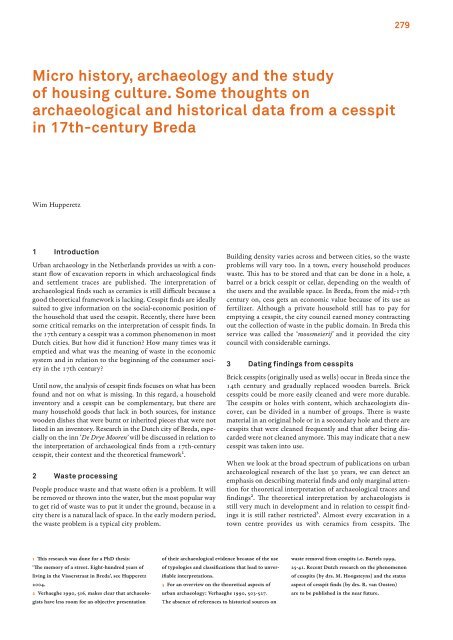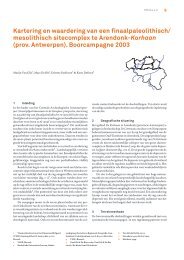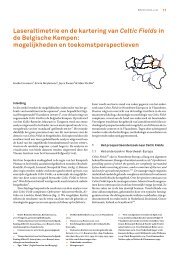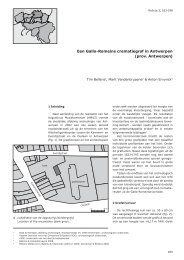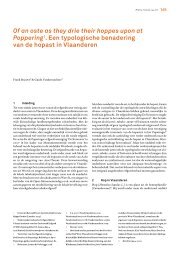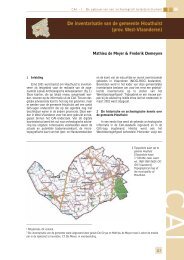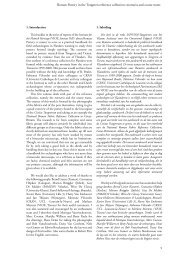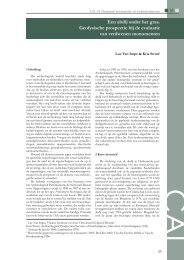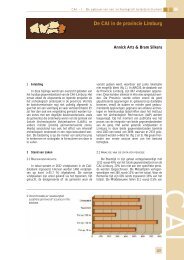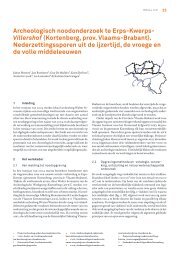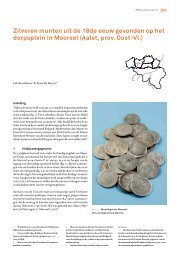Exchanging Medieval Material Culture Studies on archaeology and ...
Exchanging Medieval Material Culture Studies on archaeology and ...
Exchanging Medieval Material Culture Studies on archaeology and ...
You also want an ePaper? Increase the reach of your titles
YUMPU automatically turns print PDFs into web optimized ePapers that Google loves.
Micro history, <strong>archaeology</strong> <strong>and</strong> the study<br />
of housing culture. Some thoughts <strong>on</strong><br />
archaeological <strong>and</strong> historical data from a cesspit<br />
in 17th-century Breda<br />
Wim Hupperetz<br />
1 Introducti<strong>on</strong><br />
Urban <strong>archaeology</strong> in the Netherl<strong>and</strong>s provides us with a c<strong>on</strong>stant<br />
fl ow of excavati<strong>on</strong> reports in which archaeological fi nds<br />
<strong>and</strong> settlement traces are published. Th e interpretati<strong>on</strong> of<br />
archaeological fi nds such as ceramics is still diffi cult because a<br />
good theoretical framework is lacking. Cesspit fi nds are ideally<br />
suited to give informati<strong>on</strong> <strong>on</strong> the social-ec<strong>on</strong>omic positi<strong>on</strong> of<br />
the household that used the cesspit. Recently, there have been<br />
some critical remarks <strong>on</strong> the interpretati<strong>on</strong> of cesspit fi nds. In<br />
the 17th century a cesspit was a comm<strong>on</strong> phenomen<strong>on</strong> in most<br />
Dutch cities. But how did it functi<strong>on</strong>? How many times was it<br />
emptied <strong>and</strong> what was the meaning of waste in the ec<strong>on</strong>omic<br />
system <strong>and</strong> in relati<strong>on</strong> to the beginning of the c<strong>on</strong>sumer society<br />
in the 17th century?<br />
Until now, the analysis of cesspit fi nds focuses <strong>on</strong> what has been<br />
found <strong>and</strong> not <strong>on</strong> what is missing. In this regard, a household<br />
inventory <strong>and</strong> a cesspit can be complementary, but there are<br />
many household goods that lack in both sources, for instance<br />
wooden dishes that were burnt or inherited pieces that were not<br />
listed in an inventory. Research in the Dutch city of Breda, especially<br />
<strong>on</strong> the inn ‘De Drye Mooren’ will be discussed in relati<strong>on</strong> to<br />
the interpretati<strong>on</strong> of archaeological fi nds from a 17th-century<br />
cesspit, their c<strong>on</strong>text <strong>and</strong> the theoretical framework1.<br />
2 Waste processing<br />
People produce waste <strong>and</strong> that waste oft en is a problem. It will<br />
be removed or thrown into the water, but the most popular way<br />
to get rid of waste was to put it under the ground, because in a<br />
city there is a natural lack of space. In the early modern period,<br />
the waste problem is a typical city problem.<br />
1 Th is research was d<strong>on</strong>e for a PhD thesis:<br />
‘Th e memory of a street. Eight-hundred years of<br />
living in the Visserstraat in Breda’, see Hupperetz<br />
2004.<br />
2 Verhaeghe 1990, 516, makes clear that archaeologists<br />
have less room for an objective presentati<strong>on</strong><br />
of their archaeological evidence because of the use<br />
of typologies <strong>and</strong> classifi cati<strong>on</strong>s that lead to unverifi<br />
able interpretati<strong>on</strong>s.<br />
3 For an overview <strong>on</strong> the theoretical aspects of<br />
urban <strong>archaeology</strong>: Verhaeghe 1990, 503-527.<br />
The absence of references to historical sources <strong>on</strong><br />
279<br />
Building density varies across <strong>and</strong> between cities, so the waste<br />
problems will vary too. In a town, every household produces<br />
waste. Th is has to be stored <strong>and</strong> that can be d<strong>on</strong>e in a hole, a<br />
barrel or a brick cesspit or cellar, depending <strong>on</strong> the wealth of<br />
the users <strong>and</strong> the available space. In Breda, from the mid-17th<br />
century <strong>on</strong>, cess gets an ec<strong>on</strong>omic value because of its use as<br />
fertilizer. Although a private household still has to pay for<br />
emptying a cesspit, the city council earned m<strong>on</strong>ey c<strong>on</strong>tracting<br />
out the collecti<strong>on</strong> of waste in the public domain. In Breda this<br />
service was called the ‘moosmeierij’ <strong>and</strong> it provided the city<br />
council with c<strong>on</strong>siderable earnings.<br />
3 Dating findings from cesspits<br />
Brick cesspits (originally used as wells) occur in Breda since the<br />
14th century <strong>and</strong> gradually replaced wooden barrels. Brick<br />
cesspits could be more easily cleaned <strong>and</strong> were more durable.<br />
Th e cesspits or holes with c<strong>on</strong>tent, which archaeologists discover,<br />
can be divided in a number of groups. Th ere is waste<br />
material in an original hole or in a sec<strong>on</strong>dary hole <strong>and</strong> there are<br />
cesspits that were cleaned frequently <strong>and</strong> that aft er being discarded<br />
were not cleaned anymore. Th is may indicate that a new<br />
cesspit was taken into use.<br />
When we look at the broad spectrum of publicati<strong>on</strong>s <strong>on</strong> urban<br />
archaeological research of the last 30 years, we can detect an<br />
emphasis <strong>on</strong> describing material fi nds <strong>and</strong> <strong>on</strong>ly marginal attenti<strong>on</strong><br />
for theoretical interpretati<strong>on</strong> of archaeological traces <strong>and</strong><br />
fi ndings2. Th e theoretical interpretati<strong>on</strong> by archaeologists is<br />
still very much in development <strong>and</strong> in relati<strong>on</strong> to cesspit fi ndings<br />
it is still rather restricted3. Almost every excavati<strong>on</strong> in a<br />
town centre provides us with ceramics from cesspits. Th e<br />
waste removal from cesspits i.e. Bartels 1999,<br />
25-41. Recent Dutch research <strong>on</strong> the phenomen<strong>on</strong><br />
of cesspits (by drs. M. Hoogsteyns) <strong>and</strong> the status<br />
aspect of cesspit fi nds (by drs. R. van Oosten)<br />
are to be published in the near future.


